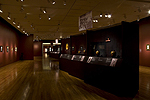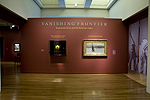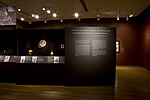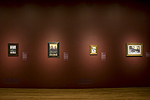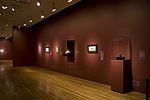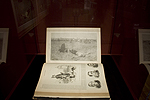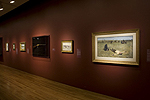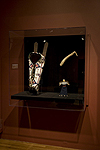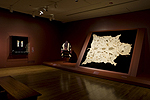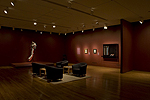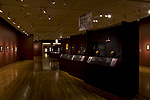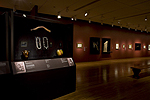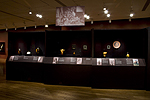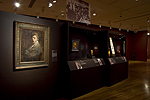The browser will either open the file, download it, or display a dialog.
|
Vanishing Frontier: Rookwood, Farny, and the American Indian Catalogues: |
||||||
|
“Farny, the nation owes you a great debt. It does not realize this now, but it will some day. You are preserving for future generations phases of American history that rapidly are passing away.” “Indian heads, which started the present craze for things Indian, are as effective as ever.” |
|||||||
|
The Exhibition The Cincinnati Art Museum (CAM) recently mounted a path-breaking exhibition featuring two Cincinnati-based subjects of international renown, Rookwood pottery and paintings by the American artist Henry Farny (1847-1916), both depicting Plains Indians at the turn of the nineteenth century. Museum curators originally conceived of these topics as two independent shows, but Director Aaron Betsky—whose CAM tenure began in late 2006—suggested that they be combined. The marriage was a fortuitous and enlightening one. This exhibition is the first dedicated to Rookwood’s American Indian subject matter and, aesthetically, all of the pottery in the show comes from the foremost collection of its kind. There had been displays of Farny oils in the past, but this one focused on the gouaches. (Earlier shows included two in 1997 at CAM and the Taft Museum of Art, a recent one of five paintings at the Taft in 2006, and others in 1983-84 at the University of Texas, Austin; in 1981 at the University of Notre Dame; in 1975 at the Indian Hill Historical Museum Association in Cincinnati; and in 1965 and 1943 at CAM.) Local exhibitions were not accompanied by extensive exhibition catalogues, although there were a couple of brief brochures. The scholarship in the current catalogues does much to advance the work of Denny Carter, a former CAM curator, whose monograph has been the reigning source on Farny since 1978. A good number of the paintings had not been seen by the public in more than a decade; half are in local private collections and the other half (nineteen of them) belongs to the museum. |
|||||||
|
The darkly glowing exhibition filled two large, second-floor galleries that were painted maroon. Lining the walls, and the edges of the galleries were thirty-seven Farny paintings (two in oil, the rest gouache and/or watercolor), a chalk drawing, and a small bronze sculpture—all of them dated between c. 1883 and c. 1910—as well as several cases of nineteenth-century Indian-made objects from the CAM, the Cincinnati Museum Center, and private collections. These surrounded two sets of large glass cases centered in each room and filled with fifty-two examples of Rookwood (1881-1903) all from the nation’s premier private collection of American art pottery, owned by Cincinnatian James J. Gardner (fig. 1). |
|||||||
|
Opening the exhibition was a Rookwood vase (with no explanatory label) depicting a Wichita woman, Nasuteas-Kichai, that Matt Daly decorated in 1899, as well as a beloved iconic Farny oil painting from the Taft Museum of Art, Song of the Talking Wire (1904), with a label describing the image as a “doomed Indian” (fig. 2). This phrase underscores the principal themes of the show, a disappearing way of American life and a strong sense of longing and loss. To the right, separating the two galleries, were large vertical scrims—photographic enlargements of Indians, both by Frank Albert Rinehart in 1898. On the left was White Man, Kiowa-Apache and on the right was Sleeping Bear, Lakota Sioux, Sicangu or Brulé Band. Unidentified except in the Rookwood catalogue, they serve, ironically, as anonymous totems, solemn witnesses to the display. |
|||||||
|
On the opposite side of the panel supporting the vase and painting was a bright corridor leading to the second gallery, lit by wall-sized windows. The back of the panel featured a map of the U.S., identifying federal and state reservations c. 1900. The source (Houghton Mifflin’s Encyclopedia of North American Indians, 1996) was not given, but the map is reproduced in fuller detail after the Introduction in the Rookwood catalogue. Although there was an introductory panel, there were no large captions to guide viewers, and so the order of the installation was not immediately apparent. Modest-sized headers, such as “Warriors and Women,” “Tipis and Buffalo,” “Medicine Men, Missionaries, and Technology,” and “Northwest / Southwest Coast,” revealed a thematic arrangement. Additionally, there were enlargements of brief, evocative quotations, such as an excerpt from historian Frederick Jackson Turner’s significant speech at the World’s Columbian Exposition in 1893 about the closing of the frontier: “And now the frontier has gone, and with its going has closed the first period of American history.” Another quotation was from Theodore Roosevelt paying homage to Farny’s Indian scenes (cited above). In gold lettering against a dark red background, the words were not highly legible (fig. 3, far right side). |
||||||
|
The gouaches, although vibrant and masterful, are mostly small, ranging in size from 9 ¾” x 7 ¾” to 22 5/16” x 40”; and the sparse, evenly horizontal installation had a ring-around-the-bathtub feel. The second painting, Ford (1899) with Farny’s visually striking trademark “lemon sky,” is also reproduced on the cover of the Farny catalogue (fig. 4). Occasionally a glass case near a corner enlivened the space with more three-dimensionality, such as the one with a small bronze head of a Zuni woman (1899), an example of Farny’s occasional forays into Indian sculptures (fig. 5). Of special interest were the cases containing bound copies of Harper’s Weekly magazines opened to illustrations by Farny, like The Prisoner (1886) a nearly identical wood engraving after the celebrated painting, The Captive (which won the $250 cash prize by popular vote at the American Art Association exhibition in 1885); and A Dance of the Crow Indians (1883), after an eponymous painting from the same year (figs. 6, 7). Labels were brief, usually offering new ethnological information about clothing and accessories, with some historical background and aesthetic commentary. Some were repetitive, such as Winter Squaw, 1900 and A Young Squaw, 1892 which explained that “squaw” was a derogatory term meaning prostitute; and Sioux Brave, 1892 and The Medicine Man, 1892 which stated that catlinite is a red stone quarried in southwest Minnesota, named after painter George Catlin. (Since the term “squaw” is actually even more vulgar than prostitute, it may be that the curators wanted to make sure that viewers would get the message that it shouldn’t be used.) A few images were accompanied by very useful historical photographs, such as those depicting the Rookwood building (1898) and Lakota Sioux at the Cincinnati Zoological Gardens (1896). The final section before the exit to the gift shop, “Media Stereotypes,” had two large, colorful lithographs by the Strobridge Company in Cincinnati. These were posters, S.H. Barrett & Co.’s New United Monster Rail-Shows / Snake, Flat-head, and Mexican Indians (1881-82) and Sells Floto Circus / 30 Minutes with Buffalo Bill (1923). Neither one, lamentably, had an explanatory label or was reproduced in the catalogues. It almost seems as they were added as afterthoughts to fill the space. |
|||||||
|
The wall cases with Indian objects, such as a baby carrier, hide scraper, and female doll offered anthropological and aesthetic comparisons with the pottery and paintings (fig. 8). Other Indian and Western artifacts on display were a Winchester repeating firearm, a bow case and quiver, a war club, a knife sheath, war bonnets, parfleches, a tobacco bag, a water jug, a pump drill, a pipe, men’s leggings, and moccasins. Especially dramatic were the large, outstretched buffalo skin (a Sioux buffalo wearing robe) and a Navajo wearing blanket, third phase (fig. 9). Almost none of these had contextual labels. Most of the objects were made by the Plains Indians, such as Crow, Blackfoot, Cheyenne, Apache and others who were perceived as the stereotype of the frontier. Some items were mounted near paintings that had depictions of similar pieces; otherwise, there was no clear order. Unfortunately, none of these objects was reproduced or discussed in the catalogues, but they added to the ambience. A back portion of the gallery on a square carpet offered space for rest and more information; there were catalogues on two end tables flanked by four comfortable armchairs (fig. 10). |
|||||||
|
More than half of pottery was vases (28 of them), but there were also plaques, pitchers, loving cups, jugs, and mugs from ale sets, and some of the vessels had handles overlaid by copper or silver. The Rookwood, nearly all with underglaze decoration, was mounted in sets of three or four tall glass cases placed diagonally in the center of the galleries, slightly staggered (fig. 11). This made for a more dynamic arrangement than cases parallel to the walls. The display of the Rookwood on black or brown velvet was especially compelling because a source photograph from the Bureau of Ethnology, enlarged to approximately 11” x 8 ½”, accompanied every piece, and featured the Indian whose portrait appeared on the pottery. (The exception was a piece for which the source was a Wild West show poster.) The company purchased these images, made by such renowned photographers as Alexander Gardner (1821-1882) and John K. Hillers (1843-1935), from the Smithsonian Institution. Arranged on a slight incline beside the labels, these portraits led the eye to the pottery and offered viewers a chance to compare and contrast the imagery, observing the ways in which decorators chose to alter and simplify compositions. Some of the individual cases with just two small objects were rather bare with much dead space above. Others had more visually engaging and colorful compositions, better balanced in height and width with Indian-made items like a throwing stick and necklaces (fig. 12). The groupings were aesthetic and organized by decorator, not chronologically. For instance, one set of three objects comprised a crucible pitcher by Bruce Horsfall (1895), a plaque with a portrait head of Blackfoot John Grass by Farny (1881), and a vase portraying an Indian scout by Horsfall (1893). |
|||||||
|
Above each set of cases was a scrim (approximately three by four feet) with reproductions of photographs. One was a triple portrait of artists Frank Dengler, Frank Duveneck, and Henry Farny in Duveneck’s studio in 1875 by an unknown photographer (fig. 13). Another is of Duveneck’s first class at the Art Academy of Cincinnati; both men and women were taught together in a studio located on the third floor of the CAM, 1890-91 (fig. 14). In the lower center of the latter image is a reclining, melancholic black man, whose portrait is on the easel at left. Although a label identifies the site, no further information is given because of a lack of space on the case. There could have been a compelling discussion of the model, with comparisons between the marginal status of African Americans and American Indians at this time. Another opportunity was lost with this arrangement; seemingly, there was no appropriate room to adequately sketch Rookwood’s history anywhere in the exhibition. However, this topic is covered in detail in the catalogue. |
|||||||
|
The Catalogues Rookwood and the American Indian: Masterpieces of American Pottery from the James J. Gardner Collection is a sumptuous, full-color exhibition catalogue of Gardner’s collection of Rookwood art pottery featuring American Indian portraiture. The publication is beautifully assembled, featuring a large, attractive font with plenty of white space and blank pages separating sections. The volume begins with a 1 ½-page foreword by George P. Horse Capture, Sr., Senior Counselor to the Director Emeritus, National Museum of the American Indian, Smithsonian Institution. From the preface by Anita Ellis, CAM Deputy Director in charge of Curatorial Affairs, we learn that James Gardner and his wife, Joan, began collecting Rookwood in 1988 because “Jim” liked it, and he is an “exceptionally fine gentleman,” but we discover little else about the collectors. There are two essays, one by consulting ethnologist, Susan Labry Meyn, Ph.D., and the other by co-curator Ellis. Both follow a similar format with italicized, centered subheadings. This makes for reader-friendly perusing but gets excessive at times, especially when transitions are lacking and sections are frequently as brief as one to three paragraphs. On all facing pages are abbreviated essay titles and the author’s name centered at bottom; this is needless. Both contributions, however, make for compelling reading and are chock full of fascinating material based on a tremendous amount of original research, a good portion of it taken painstakingly from local primary sources. |
|||||||
|
Meyn’s essay, “Enduring Encounters: Cincinnatians and American Indians to 1900,” is ambitious, spanning over 110 years in just fifty-two pages, and amply footnoted. Meyn describes American Indian activities in Cincinnati from the time of the first settlers up until 1900, and relates these events to national policy. She argues that the legacies of diverse encounters between whites and Indians endure to this day, and that the quest for authentic history is complicated by the inaccuracy and sheer wild invention of most of the early material. She gives a survey of such topics as early settler and Indian conflicts; Indians in popular literature; Indian mounds; and Cincinnati archeology. She interweaves local developments with national trends and events, such as Cincinnati’s Western Museum, the rise of expositions and the role of anthropology in them, the appearance of live Indians at fairs, Indian delegations and visits, Great Plains Indians and the public imagination, Cincinnati and the Indian Removal Act of 1830, Buffalo Bill and the Wild West, the tragedy at Wounded Knee, Indians in 1890, the closing of the frontier, and the World’s Columbian Exposition in Chicago in 1893. |
|||||||
|
This sets the stage for the longest section regarding Cincinnati’s Wild West. Here Meyn draws from her essays—each with a specialized focus—on the 1896 Rosebud Sioux (Sicangu) encampment at the Cincinnati Zoo, previously published in American Indian and Culture and Research Journal (2002), Queen City Heritage (1994), and Museum Anthropology (1992). She then offers a “pragmatic evaluation” of these events, comparing and contrasting the experiences of two groups who camped at the zoo. The first Indians arrived in the Queen City unexpectedly. After the owner of an unsuccessful Wild West show abandoned Cree Indians in Bellevue, Kentucky, the zoo’s administration invited them to go on exhibit at the zoo for two months. The additional admission revenue paid for their fare home to Havre, Montana. The following year, the Sicangu voluntarily consented to participate in a three-month, paid educational summer program that generated official documentation, photographs (six reproduced here), an unpublished manuscript (written by James Albert Green on the board of the public library, who submitted it to Harper’s Magazine), and fond memories that survived generations of both Cincinnatians and the Sioux. |
|||||||
|
In her conclusion, “American Indian Observations,” Meyn analyzes the positive and negative experiences that the Cree and Sicangu had in Cincinnati, and the ways in which their presence prompted artists like Farny to sympathize with and depict them. Such paintings were popular and fetched high prices. Plains Indian motifs (seen as the representative, stereotypical Indian) seemed ubiquitous in the Queen City in the late 1890s, appearing on invitations, party costumes, and elsewhere, although by this point the frontier had closed and most Indians were confined to reservations. |
|||||||
|
In her essay, “Rookwood and the American Indian,” Ellis explores the history and economic implications of producing that pottery line. Her research is meticulous and broad, informed by a database of over 14,000 artist-decorated works (1881 to 1955) from an estimated 500,000 total works created by Rookwood. From this pool, Ellis found 160 pieces that depict American Indians, and she bases her preliminary comments on this one percent of the company’s artist-decorated products. (She estimates that there may have been as many as 5,000 such works.) She argues that Rookwood’s policies reflect a contradictory attitude of exploitation and sympathy toward the first Americans. A renowned Rookwood scholar and the author of three books on the pottery, Ellis briefly traces Rookwood’s history with clever, although quickly predictable, theatrical subheadings such as “Enter Frank Duveneck,” “Enter Maria Longworth Nichols,” “Enter Henry Farny and the First Indian Decoration,” “Enter William Watts Taylor,” “Enter Artus Van Briggle and Indian Motifs, 1888,” and “Enter Joseph Henry Sharp,” and later, “Reenter Frank Duveneck” and “Exit Maria Longworth Storer—Taylor Takes Control.” |
|||||||
|
For culturally aware Cincinnatians, much of this is familiar territory. Locals are justly proud of the remarkable story of Rookwood, 1880-1967, which became the premier American pottery at the turn of the nineteenth century, regularly winning top national and international awards for its distinctive clays, techniques, and quality, and its unique crystalline Tiger Eye and Goldstone lines, as well as the popular Standard glaze line. Maria Longworth Nichols (1849-1932), the strong willed granddaughter of one of the wealthiest men in the U.S., founded the pottery for her own gratification and was determined to make it an enormous success. She hired only graduates from the Art Academy of Cincinnati, founded and endowed by her father, who were mostly trained by painters Duveneck, Farny, and Sharp. Nichols made William Watts Taylor the manager, and for thirty years, he was the driving force behind the business, creating what today would be called a brand identity. |
|||||||
|
In the following paragraphs it should be noted that the production numbers of Rookwood pottery portraying American Indians for any given year are based on the number of objects that Ellis found in her survey of 14,000 pieces. They do not represent the exact number that Rookwood produced; this was never recorded and would be impossible to determine. |
|||||||
|
Farny produced the first Indian decorations at Rookwood in 1881 in the form of four plaques, only one of which survives; it is an unglazed red earthenware plate featuring the profile head of the Blackfoot, John Grass. This was a stark contrast to the dominant floral mode of decoration at this time, which was designed to appeal to female customers. The next example of Indian heads on pottery came in 1888. These were prompted in part by the enormous popularity of Buffalo Bill’s Wild West show which began touring in 1883 and which was a smash in Europe in 1887, starting in London on the occasion of Queen Victoria’s Golden Jubilee. The subject matter of Indians was distinctly American, and it was also lucrative. Van Briggle experimented with this new material in 1888, incising decorations after Indian shell badge motifs published in a report by the Bureau of Ethnology of the Smithsonian Institution. The year marked Cincinnati’s Centennial, celebrated with exhibitions of hundreds of artifacts and archeological specimens by the prehistoric Mound Builders at the Cincinnati Art Museum. The following year, Van Briggle depicted a contemporary American Indian on a crucible pitcher and, in 1893 he painted three more Indian images on Rookwood. In the meantime, Nichols was widowed and married Bellamy Storer. Upon getting involved in her husband’s political career, she transferred her interest in the Pottery to Taylor. He incorporated the company, moved it to a new Tudor Revival building in Mt. Adams overlooking the Queen City, and appealed to a male market by producing wine and ale pitchers, mugs, whiskey jugs, and tobacco jars. These featured “grotesque” subject matter (not quite explained), ghosts, monks, and portraits, which became possible because of improved technology for underglaze decoration. |
|||||||
|
Ellis makes it clear that the World’s Columbian Exposition in 1893 marked a turning point historically and also in terms of Rookwood’s reputation. At the exposition Frederick Jackson Turner delivered an address since hailed as “the single most influential piece of writing in the history of American history” (82). He declared that the “frontier line” had reached its end and been obliterated, and that America’s unique sense of energy, freedom, opportunity, and identity was dependent on the frontier’s existence. If subject matter defined American art, then the West might suggest the next truly American art. Among the Rookwood pieces on view at the Columbian Exposition were two displaying Indian imagery, one by Van Briggle based on photographs purchased from the Bureau of Ethnology, and one vase decorated by Bruce Horsfall, featuring an Indian on horseback atop a grassy knoll, after a poster used to promote Buffalo Bill’s Wild West show in 1885. |
|||||||
|
In the years following the Columbian Exposition, Rookwood staff focused on introducing three new glaze lines in 1894-95. Ellis briefly states that ten Rookwood decorators were depicting American Indians in 1896, which was also when the company began using a new pyrometer, a more exact device for measuring high temperatures, which led to greater output. Rookwood’s production of Indian portraits increased dramatically from 1898 to 1900 (38 in 1898, 30 in 1899, and 29 in 1900), bolstered by the successful Indian Congress at the Omaha Trans-Mississippi and International Exposition in 1898 and the 1900 Paris Universal Exposition, where Rookwood won the Grand Prix. By 1901, however, the market began to shift in favor of matte-glazed ware, first promoted by Grueby Pottery of Boston starting in 1897. (In an otherwise deadpan style, Ellis inserts a funny subheading here—“Matte-Glazed Ware—Feeling Grueby.”) Because such pottery is opaque, it cannot support underglaze decoration. Indian portraiture continued at Rookwood (20 in 1901), but only three were made in 1902 and five in 1903. The last known such piece came out in 1904; the Pottery exhibited only a few earlier Indian works at the Louisiana Purchase Exposition in St. Louis that year. By this point the Standard glaze line was twenty years old and becoming outdated, and most of the major artists who produced Indian subject matter were gone. At the exposition, Rookwood debuted its “scenic” Vellum glaze line featuring landscapes, which marked the beginning of forty-three years of financial and aesthetic success. E.T. Hurley produced two Vellum vases with distant shadowy scenes of Indians in 1909, and Edward Diers decorated an Indian Iris vase in 1911. As Ellis declares, “Rookwood’s fascination with the American Indian had, in effect, ended by 1911.” |
|||||||
|
Only the best Rookwood decorators painted portraits because the subject matter was so demanding and the company sought the lowest loss ratio possible. The sole reason for allowing decorators to sign their names on pottery was to track sales of an artist, and by 1894 prices depended more on the quality of the decoration than on the size or technical quality of the object. Prices for portrait pieces were in the $25-50 range, and followed a strong hierarchy, favored by male decorators who earned considerably more than their female peers. Ellis judges which artists were best by assigning three categories—good, very good, and masterful. Eschewing discussion of the lowest rung, she places Artus Van Briggle, Sturgis Laurence, Harriet Wilcox, and Adeliza Sehon in the middle tier. Those in the top echelon, she believes, were Olga Geneva Reed, William McDonald, Matt Daly, and Grace Young, based on the detail and high quality of their work. |
|||||||
|
At the end of her essay Ellis argues that Rookwood’s Indian portraits were sympathetic, but the exact identities of the subjects were of little consequence, although the names of the sitters were usually inscribed on the bottoms of vessels. “It was the emotional value of the image that was important,” she asserts, and the images “almost always express longing” (115). Ellis believes that buyers at that time, and viewers today, were/are attracted to such depictions because they empathize and project their own sense of a lost way of life. By the turn of the century, the market changed because the pervading sentiment was no longer one of loss, but of expansion. Ellis might have been more precise by saying that the emphasis wasn’t on the negative note of loss, but more positive because it connoted white settlement and progress rather than expansion. The use of the word “expansion” is slightly confusing because the frontier had essentially closed. The use of the word “loss” is also problematic because whites did not lose their land, nor was there the kind of sentimental nostalgia for rural life in the United States that we see in European images of this time. It is hard to imagine whites experiencing loss over something that was firmly under their control by 1900. Perhaps what they felt was guilt or regret about some aspects of traditional Indian life that they had changed.” Ironically, Ellis states, “industrialization was the reason for the sense of loss, and industrialization was the reason for its dissipation.” Underglaze portraiture was a premiere product of industrialization helping the buyer to escape industrialization by allowing “the vicarious return to nature through the American Indian” (117). Such images are as popular as ever today, commanding tens of thousands of dollars at auction, and Cincinnatians have been clamoring for this kind of exhibition. |
|||||||
|
Ellis concludes, “Perhaps Rookwood’s self-expressive, psychologically engaging Indians retain their intimacy with today’s viewer because they mirror a compelling introspection into our own nostalgic loss” (118). That current is strong and clear, but it is certainly not the only one. The portraits express other emotions and states of being, too, ranging from stoicism and dignity to indifference, resentment, and active avoidance, to a strong sense of independence and self-possession, to being lost in one’s thoughts or focused on activities. In only one instance, a plaque of Wanstall by Grace Young, 1902, is a sitter frontal, making eye contact with viewers; the rest of the portraits are three-quarters or profile views, with eyes averted, downcast, glazed, or looking off into the distance. In another example, although the subject, a man named Songlike, stares directly at the photographer, the Rookwood decorator, again Grace Young, deliberately moved the pupils to the side on her vase. This begs the questions—who is avoiding the gaze of whom, and why? |
|||||||
|
Ellis’s original essay is a remarkable display of meticulous research and analysis. One of my few reservations about it regards the repetitive footnotes. On page 119, Ellis uses the phrase “the following information is also from this source” seven times. It appears five times on the next page, twice on page 123, and elsewhere. |
|||||||
|
The catalogue entries are arranged alphabetically by decorator, then chronologically by date of the object. The introduction to each subsection is a mini-biography of the decorator accompanied by a useful color reproduction of the artist’s typical signature on a piece of Rookwood. The biographies follow the same (and rather monotonous) formula of “Born on [insert date here] in [insert location here] “ and end with exact death dates, as well as the age of the decorator at death, which is superfluous. The entries are largely descriptive rather than evaluative, however, they are quite detailed and no doubt of strong interest to the connoisseur. On the left is a full-page color illustration of the Rookwood item. On the facing page is a quarter-page reproduction of the source image, usually a black-and-white photograph, and occasionally a color poster. In addition to the expected information—artist, title, date, medium, dimensions—there are listings of the shape designer (when known), the exact Rookwood line, the marks (impressed and incised), and transcriptions of any paper labels, as well as curatorial comments. In many cases, these are brief and anthropological, explaining the presence and use of such ornamental and clothing details as gorgets, a “strike-a-light” pouch, or a roach (hair ornament); or technical information such as the difficulty of reproducing red in Rookwood glazes. Missing, for the most part, are provenance histories and discussions of the aesthetic qualities of the items. Some entries are longer, extending to an additional page or more and including close-ups or biographical and historical information about such notable subjects as Bloody Mouth, John Grass, Joseph, Ouray, Red Cloud, Young Iron Shell, and Geronimo. Citations are awkwardly embedded in the text rather than footnoted. There are some unnecessary phrases such as “What is interesting is that…” in catalogue entry #30. Of particular note are those entries that reveal such surprises as apparent cross-dressing, as in the cases of Susie Shot in the Eye (#31) and Sleeping Bear (#41), both of whom are depicted wearing an eagle feather war bonnet. (The gender of the latter subject is uncertain because s/he also sports a hair pipe neck ornament, with pipes strung vertically around the neck, as women usually wore.) |
|||||||
|
The catalogue includes useful alphabetical appendices and bibliographies. Appendix I is a roster of the twenty-three Rookwood artists of Indian portrait decoration; the Gardner collection has examples by thirteen of them. Listed also are the dates when each decorator was at Rookwood, and his/her life dates. Appendix II names the fifteen photographers (with their life dates) of American Indians whose work was used at Rookwood. Cities are listed for eleven of them, but it is not clear whether the photographers hailed from those places or worked in them. In just seven cases dates of activity are given. There are separate bibliographies for the two essays. These are extensive, the first with 132 entries and six archival sources, the second with 96 entries and five archival sources. The first, for “Enduring Encounters,” lists page numbers (although not columns) of newspaper stories, which is extremely helpful to scholars. Unfortunately, the second does not (following the recommendation of The Chicago Manual of Style, 15th ed.), and this editorial inconsistency is regrettable. |
|||||||
|
Henry Farny Paints the Far West is a large, attractive, almost square (11 ½” x 11”) catalogue. Like the Rookwood publication, it contains a wealth of new information and gorgeous reproductions. Sadly, the tiny font induces eyestrain except, incongruously, when it more than doubles on the initial pages of each essay. It worsens when the size of the print decreases still more in the footnotes. Also, the copper-colored lettering used for subheadings, figure captions, and catalogue details is faint and hard to read against the white pages. The presence of an alternate hue, however, is useful in the two-page chronology at the end, where the metallic entries indicate national events relevant to Indians before, during, and after Farny’s life. |
|||||||
|
The handsome volume presents three essays, organized and edited by CAM Curator of Prints, Kristin Spangenberg, who also assisted with the catalogue entries. Anita Buck was the manuscript editor. CAM Director Aaron Betsky provided the foreword. Art historian Julie Schimmel’s “Images of the Dispossessed” surveys some of the iconographic traditions with which whites have depicted Indians, (particularly the “doomed” or “vanishing” Indian that first appeared in the visual arts in the 1840s. She also compares Farny with other artists of the American West, such as George Catlin, Carl Wimar, George Caleb Bingham, John Adams Elder, John Mix Stanley, and James Earl Fraser. Schimmel argues that Farny could not have made his paintings at any other time in American or Native American history. She concludes that “if Farny’s Indian figures appear immobilized,” so were the reservation Indians whose lives he witnessed” and “the past could never be revisited—except in art” (34). |
|||||||
|
Ethnologist Susan Labry Meyn’s contribution, “The Artist As Indian Storyteller,” is the principal essay. She forges new ground by closely examining Farny’s black-and-white illustrations reproduced for Harper’s Weekly and Century Magazine (beautifully reproduced here, many filling almost two-thirds of the page), not aesthetically, but in terms of ethnology and history. Meyn drives the point home by repeating the phrase, “for an ethnologist…” (51, 54, and 128). She asserts that while Farny knew a great deal about Indians, “he rarely chose to represent the devastating reality of contemporary Indian life, even in his illustrations, perhaps because the romantic past was what his public wanted and what they bought” (38). She discerns a clear disjunction between Farny’s real-life experiences with reservation-bound Indians and the romanticized traditional Indian life he so often painted. Meyn’s scholarship is informed by exacting research and extensive footnotes. She graciously acknowledges many people who provided information and, in most cases, their areas of expertise are apparent; however, it’s not quite clear who Dr. Ted Brasser and Jack Lewis are, or with which institutions they are affiliated. Curiously, Meyn’s footnote 119 about Ogallala is worded exactly the same as Schimmel’s 43, probably the result of editorial cutting and pasting, and not the fault of the authors. |
|||||||
|
CAM Art Conservator Cecile D. Mear investigates Farny’s working methods in depth in “The Artist’s Training and Materials.” She describes how he approached different media and she narrates the creation of several works from the first wash of color to the final touches of gum. Mear traces the painter’s evolution from early artistic endeavors to his work as an illustrator, and to studies on the continent and beyond. She briefly analyzes the ways he made his etchings, lithographs, watercolors, gouaches, and oils; his use of photographs; and conservation issues in his work. Mear’s study on Farny is the first extensive publication of its kind on the artist. Regrettably, there are no reproductions of a good number of works she discusses (The Silent Guest, Shoulder Length Portrait of a Warrior, Farny’s portrait of Sitting Bull, Winter, Ukchekehaskan, Silence, etc.), perhaps because these were not in the exhibition. |
|||||||
|
Full-page reproductions of works in the catalogue section are stunning. The entries are brief, two to four paragraphs long, but informative. They relate many fascinating and relevant details of ethnological and historical interest. Some, however, conclude on a dull note, stating the date when the work, or the oil on which a gouache is based, sold at auction. Occasionally, as in the exhibition, the information is repetitive, such as the definitions of catlinite on pages 105 and 159, and squaw on pages 104 and 117. Some statements are speculative and without documentation here, such as: “Perhaps Farny repented of this portrayal of the Indians he admired and cared for” (94); “Farny knew that whites wanted to see a “real” Indian—a man wearing a long eagle feather war bonnet” (98); and the assertion that a large silver-colored ornament worn as a pendant “is probably a peace medal, given to him or to a close relative by the “Great Father,” the President of the United States.” The latter sitter (of Indian on Horseback, 1891) is, after all, likely fictional, as the authors suggest, given the incongruous clothing of the hunter who seems to be dressed more for ceremony or battle than would be appropriate alone and at rest in a winter twilight scene. The language is usually precise and inclusive, so it is disappointing to see the use of the word “man” on page 113. I was eager to learn more about Farny’s sculptures, but the entry on the bronze Zuni woman’s head is just two paragraphs long, involving no formal analysis or contextual information about Farny’s other three-dimensional work. Nevertheless, Meyn has done yeoman’s work in shedding important new light on so many aspects of Indian mores and traditions. Given the wealth of this significant scholarship, we can never look at Farny’s images in the same way again. |
|||||||
|
As a whole, the exhibition and two catalogues comprise a notable contribution to studies of nineteenth-century art and history as the first extensive examination of American Indian depictions by both Henry Farny and Rookwood in Cincinnati, especially because the project is based on Farny’s gouaches (rather than his oils) and on remarkable examples of pottery in the foremost collection of its kind. The pioneering and in-depth research by Anita Ellis, Susan Labry Meyn, and Cecile Mear, in particular, makes the publications essential resources for curators, scholars, dealers, and collectors. |
|||||||
|
Theresa Leininger-Miller |
|||||||


